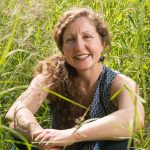Our forests can make Oregon the first carbon-neutral state
By Dominick A. DellaSala, Posted April 21, 2018 at The Oregonian
As a forest ecologist, I have argued for decades that public forests need to be protected as our irreplaceable natural legacy. New studies from Oregon State University and Oregon’s Global Warming Commission Task Force on Forest Carbon show that there are critically important climate benefits to be added that could make Oregon the nation’s first carbon-neutral state if forestry practices are improved.
It turns out that Oregon’s forests are nature’s cooling towers. Through the process of photosynthesis, forests absorb atmospheric carbon and use it to make their food (sugar), storing excess carbon in tree trunks, plants and soils for centuries. When forests are cut down, most of this stored carbon is released to the atmosphere as a global warming pollutant from decomposing logging slash and the transport and manufacture of wood products. Forest loss globally accounts for some 17 percent of these pollutants. Clearcutting, mainly on private lands, and the sell-off of 320,000 acres of family-owned forests since 1974, is limiting the capacity of forests in Oregon to provide climate savings.
Summary of Oregon’s forest carbon findings
Geos Institute partnered with the Center for Sustainable Economy in 2015 on a ground-breaking report that identified Oregon’s forestry practices as among the top global warming polluters in the state. That report triggered the formation of a task force on carbon appointed by Governor Kate Brown to which our Chief Scientist sits on. The task force recently released its forest carbon findings and Geos Institute sent a summary to Oregon state legislatures. Read it here.
Why does this famous protector of trees now want to cut some down?
By Warren Cornwall, Oct. 5, 2017, for Science Magazine
WESTERN OREGON—Jerry Franklin has spent much of his life in the company of giants. From his childhood in the woods of Washington state to a scientific career that catapulted him to international prominence, the towering trees of the U.S. Pacific Northwest have shaped his world. In the 1980s, the forest ecologist became a hero to many conservationists thanks to research that helped lead to a controversial 1994 plan protecting millions of hectares of old-growth forests in the Pacific Northwest from logging.
Today, in the twilight of his life, the 80-year-old scientist has become a champion of this far different landscape, which he sees as vital to supporting a full range of forest species. That change has again thrust Franklin, a professor at the University of Washington in Seattle, to the center of a debate over the future of the northwest’s forests—including a potential rewrite of that seminal 1990s Northwest Forest Plan. This time, Franklin is drawing the ire of conservationists for promoting forest management techniques—including targeted logging—designed to create more of the scraggly patches of protoforest that ecologists call “early seral” communities.
Forest ecologist Dominick DellaSala, president of the Ashland-based Geos Institute, is convinced that logging is a poor substitute for natural disturbances, which leave a complex jumble of live and dead trees. DellaSala was Franklin’s co-author on the 2011 paper about the importance of early seral habitat, but he has become Franklin’s chief scientific critic. Franklin, he says, “thinks you can recreate [seral habitat] from nothing. And I think you can’t recreate it from nothing. You’ve got to start with something and just not salvage log it.”
Read the full article at sciencemag.org
Details emerge on proposed monument cutbacks
 From High Country News, August 24, 2017
From High Country News, August 24, 2017
Interior Secretary Ryan Zinke has completed his long-awaited review of 21 national monuments and recommending a handful be reduced in size including the Cascade-Siskiyou National Monument in Oregon. Climate change was a main reason to expand the Cascade-Siskiyou, as researchers pressed the Obama administration to protect whole watersheds and reduce habitat fragmentation between the Cascade and Siskiyou mountains.
“It’s the only functional land bridge making that connection,” says Dominick DellaSala, president and chief scientist at the Geos Institute, who was involved with research on the monument’s role in climate resilience. He describes Cascade-Siskiyou, which encompasses a wide variety of habitats including oak woodlands, mixed conifer stands and chaparral, as the first monument to biodiversity. “Traditional uses like logging are land-use stressors that are incompatible with the monument’s biodiversity.”
In fact, researchers pushed for a far larger expansion than the one Obama enacted. “This is the last place any kind of monument reduction should be attempted,” DellaSala says. “Reducing the boundaries is not scientifically defensible.”
Details emerge on proposed monument cutbacks
 From High Country News, August 24, 2017
From High Country News, August 24, 2017
Interior Secretary Ryan Zinke has completed his long-awaited review of 21 national monuments and recommending a handful be reduced in size including the Cascade-Siskiyou National Monument in Oregon. Climate change was a main reason to expand the Cascade-Siskiyou, as researchers pressed the Obama administration to protect whole watersheds and reduce habitat fragmentation between the Cascade and Siskiyou mountains.
“It’s the only functional land bridge making that connection,” says Dominick DellaSala, president and chief scientist at the Geos Institute, who was involved with research on the monument’s role in climate resilience. He describes Cascade-Siskiyou, which encompasses a wide variety of habitats including oak woodlands, mixed conifer stands and chaparral, as the first monument to biodiversity. “Traditional uses like logging are land-use stressors that are incompatible with the monument’s biodiversity.”
In fact, researchers pushed for a far larger expansion than the one Obama enacted. “This is the last place any kind of monument reduction should be attempted,” DellaSala says. “Reducing the boundaries is not scientifically defensible.”
Geos Institute asks U.S. Fish & Wildlife Service to increase protections for the imperiled marbled murrelet

The marbled murrelet, a robin-size coastal seabird, is unique in nesting in old-growth rainforests along the Pacific Coast of northern California, Oregon, and Washington. It has been declining mainly from habitat loss due to logging, gill net fisheries, and oil pollution. Geos Institute sent detailed comments to the U.S. Fish & Wildlife Service to up-list the species from threatened to endangered due to ongoing habitat loss and ill-effects of climate change on coastal marine waters.
In defense of the Cascade-Siskiyou National Monument expansion
 Interior Secretary Ryan ZInke has begun a controversial and scientifically incredulous review of 25 national monuments for possible reductions in protections, including the Cascade-Siskiyou National Monument in southwest Oregon and northern California. Geos Institute played a supportive science role in designation of the monument (as well as other national monuments) in 2000. We are now defending this monument from possible rollbacks of the Trump administration.
Interior Secretary Ryan ZInke has begun a controversial and scientifically incredulous review of 25 national monuments for possible reductions in protections, including the Cascade-Siskiyou National Monument in southwest Oregon and northern California. Geos Institute played a supportive science role in designation of the monument (as well as other national monuments) in 2000. We are now defending this monument from possible rollbacks of the Trump administration.
Read the letter we sent to Mr. James Cason, Special Assistant, Delegated the Functions, Duties, and Responsibilities of the Deputy Secretary of the Interior.
In defense of the Cascade-Siskiyou National Monument expansion
 Interior Secretary Ryan ZInke has begun a controversial and scientifically incredulous review of 25 national monuments for possible reductions in protections, including the Cascade-Siskiyou National Monument in southwest Oregon and northern California. Geos Institute played a supportive science role in designation of the monument (as well as other national monuments) in 2000. We are now defending this monument from possible rollbacks of the Trump administration.
Interior Secretary Ryan ZInke has begun a controversial and scientifically incredulous review of 25 national monuments for possible reductions in protections, including the Cascade-Siskiyou National Monument in southwest Oregon and northern California. Geos Institute played a supportive science role in designation of the monument (as well as other national monuments) in 2000. We are now defending this monument from possible rollbacks of the Trump administration.
Read the letterRead the letter we sent to Mr. James Cason, Special Assistant, Delegated the Functions, Duties, and Responsibilities of the Deputy Secretary of the Interior. (photo: D. DellaSala)
Northwest Forest Plan Under Review
 Since 1994, the Northwest Forest Plan has been providing protections for millions of acres of old-growth forests, imperiled spotted owls, hundreds of rare species, and wild salmon on federal lands in Washington, Oregon, and California. Without the Plan’s protections, all old-growth forests, aside from remote areas, would likely have been destroyed sometime this decade by unsustainable logging. This is why hundreds of scientists and conservation groups have worked hard to uphold the protections afforded these forests for over two decades.
Since 1994, the Northwest Forest Plan has been providing protections for millions of acres of old-growth forests, imperiled spotted owls, hundreds of rare species, and wild salmon on federal lands in Washington, Oregon, and California. Without the Plan’s protections, all old-growth forests, aside from remote areas, would likely have been destroyed sometime this decade by unsustainable logging. This is why hundreds of scientists and conservation groups have worked hard to uphold the protections afforded these forests for over two decades.
Northwest Forest Plan Under Review
 Since 1994, the Northwest Forest Plan has been providing protections for millions of acres of old-growth forests, imperiled spotted owls, hundreds of rare species, and wild salmon on federal lands in Washington, Oregon, and California. Without the Plan’s protections, all old-growth forests, aside from remote areas, would likely have been destroyed sometime this decade by unsustainable logging. This is why hundreds of scientists and conservation groups have worked hard to uphold the protections afforded these forests for over two decades.
Since 1994, the Northwest Forest Plan has been providing protections for millions of acres of old-growth forests, imperiled spotted owls, hundreds of rare species, and wild salmon on federal lands in Washington, Oregon, and California. Without the Plan’s protections, all old-growth forests, aside from remote areas, would likely have been destroyed sometime this decade by unsustainable logging. This is why hundreds of scientists and conservation groups have worked hard to uphold the protections afforded these forests for over two decades.
Latest News
Stay Updated!
Sign up to stay updated on our current initiatives and receive information you can use to build resilience in your community.

 Arsum is the Senior Adaptation and Coastal Resilience Specialist for the National Wildlife Federation’s Southcentral Region. In this role, she advances climate adaptation efforts, with a focus on nature-based approaches to address the impacts of climate change and extreme events across the Gulf region. She has authored and co-authored numerous publications on climate impact assessments and adaptation solutions. Additionally, she regularly participates in state-based coastal resilience and hazard mitigation planning across the Gulf, collaborating with regional and local stakeholders.
Arsum is the Senior Adaptation and Coastal Resilience Specialist for the National Wildlife Federation’s Southcentral Region. In this role, she advances climate adaptation efforts, with a focus on nature-based approaches to address the impacts of climate change and extreme events across the Gulf region. She has authored and co-authored numerous publications on climate impact assessments and adaptation solutions. Additionally, she regularly participates in state-based coastal resilience and hazard mitigation planning across the Gulf, collaborating with regional and local stakeholders. Frank is the former President of the Reinsurance Association of America. Frank currently serves on the Advisory Board of the OECD’s International Network for the Financial Management of Large-Scale Disasters, the RAND Center on Catastrophic Risk Management and Compensation, and the University of Cincinnati’s Carl H. Lindner III Center for Insurance and Risk Management Advisory Board.
Frank is the former President of the Reinsurance Association of America. Frank currently serves on the Advisory Board of the OECD’s International Network for the Financial Management of Large-Scale Disasters, the RAND Center on Catastrophic Risk Management and Compensation, and the University of Cincinnati’s Carl H. Lindner III Center for Insurance and Risk Management Advisory Board. Jim is a multilingual world traveler. Based in Bavaria during the 1970s, Jim spent most of this period in India, Afghanistan and Nepal, where he founded and operated a charitable medical clinic serving Tibetan Refugees. He settled in Oregon in 1983 on a forested ranch in the Umpqua National Forest.
Jim is a multilingual world traveler. Based in Bavaria during the 1970s, Jim spent most of this period in India, Afghanistan and Nepal, where he founded and operated a charitable medical clinic serving Tibetan Refugees. He settled in Oregon in 1983 on a forested ranch in the Umpqua National Forest. Dr. Micah Hahn is an Associate Professor of Environmental Health in the Institute for Circumpolar Health Studies at the University of Alaska-Anchorage. She received her joint PhD in Epidemiology / Environment and Resources from the University of Wisconsin-Madison and her MPH in Global Environmental Health from Emory University. Subsequently, she was a postdoctoral fellow for the CDC Climate and Health Program, and in this position worked collaboratively with the CDC Division of Vector-borne Diseases and the National Center for Atmospheric Research. Her research focuses on understanding the health impacts of climate change and working with communities to develop locally-relevant adaptation and resilience-building strategies. Dr. Hahn is also on the Management Team of the Alaska Climate Adaptation Science Center.
Dr. Micah Hahn is an Associate Professor of Environmental Health in the Institute for Circumpolar Health Studies at the University of Alaska-Anchorage. She received her joint PhD in Epidemiology / Environment and Resources from the University of Wisconsin-Madison and her MPH in Global Environmental Health from Emory University. Subsequently, she was a postdoctoral fellow for the CDC Climate and Health Program, and in this position worked collaboratively with the CDC Division of Vector-borne Diseases and the National Center for Atmospheric Research. Her research focuses on understanding the health impacts of climate change and working with communities to develop locally-relevant adaptation and resilience-building strategies. Dr. Hahn is also on the Management Team of the Alaska Climate Adaptation Science Center. Michael is a former Founding Principal of Resilient Cities Catalyst, a global non-profit helping cities and their partners tackle their toughest challenges. He is currently the Executive Director of Climate Resilience Academy at the University of Miami.
Michael is a former Founding Principal of Resilient Cities Catalyst, a global non-profit helping cities and their partners tackle their toughest challenges. He is currently the Executive Director of Climate Resilience Academy at the University of Miami. Dr. Quintus Jett is a consultant, educator, and strategist for public causes. He has a doctorate in Organizations & Management from Stanford University, and a two-decade faculty career which spans schools, departments, and programs of business, engineering, liberal studies, divinity, and public and nonprofit management. Following Hurricane Katrina in 2005, Dr. Jett launched a volunteer project in New Orleans, which enlisted residents, students from over a dozen colleges and universities, and hundreds of others to field map the city’s Gentilly district, Lower Ninth Ward, and New Orleans East. Dr. Jett is an innovator in higher education, bridging the divide between academic research and the other priorities of the modern university, including student access and diversity, community engagement, and providing foundations for life-long learning in today’s rapidly changing world.
Dr. Quintus Jett is a consultant, educator, and strategist for public causes. He has a doctorate in Organizations & Management from Stanford University, and a two-decade faculty career which spans schools, departments, and programs of business, engineering, liberal studies, divinity, and public and nonprofit management. Following Hurricane Katrina in 2005, Dr. Jett launched a volunteer project in New Orleans, which enlisted residents, students from over a dozen colleges and universities, and hundreds of others to field map the city’s Gentilly district, Lower Ninth Ward, and New Orleans East. Dr. Jett is an innovator in higher education, bridging the divide between academic research and the other priorities of the modern university, including student access and diversity, community engagement, and providing foundations for life-long learning in today’s rapidly changing world. Scott is Monfort Professor of Atmospheric Science at Colorado State University. He has written about 100 publications in the peer-reviewed climate literature, is a former editor of the Journal of Climate, and served for five years as founding Science Chair of the North American Carbon Program.
Scott is Monfort Professor of Atmospheric Science at Colorado State University. He has written about 100 publications in the peer-reviewed climate literature, is a former editor of the Journal of Climate, and served for five years as founding Science Chair of the North American Carbon Program. Linda has many years of experience in disaster preparedness and resilience. She has been an elected official on the Linn County Iowa Board of Supervisors, Chair of the Metropolitan Planning Organization, the East Central Iowa Council of Governments, the statewide Mental Health Developmental Disability and the Linn County Board of Health. Langston is a former president of the National Association of Counties (2013-2014).
Linda has many years of experience in disaster preparedness and resilience. She has been an elected official on the Linn County Iowa Board of Supervisors, Chair of the Metropolitan Planning Organization, the East Central Iowa Council of Governments, the statewide Mental Health Developmental Disability and the Linn County Board of Health. Langston is a former president of the National Association of Counties (2013-2014). Ken works with families and organizations as a mediator, organizational consultant, trainer and facilitator. Along with his passion for helping people prepare for and reduce climate change, Ken also volunteers as a mediator through Mediation Works and is passionate about supporting youth through mentoring with Boys to Men of Southern Oregon.
Ken works with families and organizations as a mediator, organizational consultant, trainer and facilitator. Along with his passion for helping people prepare for and reduce climate change, Ken also volunteers as a mediator through Mediation Works and is passionate about supporting youth through mentoring with Boys to Men of Southern Oregon. Matthew is a retired high school teacher who was once honored as Oregon High School Social Studies Teacher of the Year. Before his teaching career he was in the restaurant business in Portland. He is also a lawyer who has been a member of the Oregon State Bar Association since 1980.
Matthew is a retired high school teacher who was once honored as Oregon High School Social Studies Teacher of the Year. Before his teaching career he was in the restaurant business in Portland. He is also a lawyer who has been a member of the Oregon State Bar Association since 1980. Andrea is the Resilience Policy Advisor for the North Carolina Office of Recovery and Resiliency. She works across state agencies and with local governments to increase the state’s resilience to the impacts of climate change.
Andrea is the Resilience Policy Advisor for the North Carolina Office of Recovery and Resiliency. She works across state agencies and with local governments to increase the state’s resilience to the impacts of climate change.